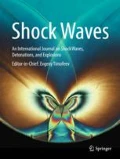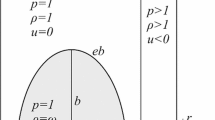Abstract
Two-dimensional shock–bubble interaction is an analogy of the steady three-dimensional jet flow in a scramjet. On the basis of Navier–Stokes simulations, a cylindrical bubble embedded with hydrogen surrounded by air was accelerated by a shock. The evolution can be divided into the lobe-emergence stage, the back-lobe suction stage, and the equilibrium stage. Based on the inhomogeneity between the hydrogen mass fraction and the vorticity field, a correlation coefficient is proposed to quantitatively determine the starting moment of the equilibrium stage. In the equilibrium stage, quasi-Gaussian distributions are modeled for the mass fraction and the vorticity. Surface integrals are performed to derive corresponding mixedness and circulation models, both controlled by two statistical parameters (standard deviation and peak value). Such Gaussian integrated models are universal for different cylindrical bubble aspect ratios (\(\mathrm {AR}=0.5\)–2) and shock Mach numbers (\(M=1.22\)–2). They provide a statistical perspective of late-time SBI evolution in addition to the description from certain physical quantities and help better understand the compressible mixing of scramjet combustors.















Similar content being viewed by others
References
Meshkov, E.: Instability of the interface of two gases accelerated by a shock wave. Fluid Dyn. 4(5), 101–104 (1969). https://doi.org/10.1007/bf01015969
Richtmyer, R.D.: Taylor instability in shock acceleration of compressible fluids. Commun. Pure Appl. Math. 13(2), 297–319 (1960). https://doi.org/10.1002/cpa.3160130207
Ranjan, D., Oakley, J., Bonazza, R.: Shock-bubble interactions. Annu. Rev. Fluid Mech. 43, 117–140 (2011). https://doi.org/10.1146/annurev-fluid-122109-160744
Marble, F.E., Hendricks, G.J., Zukoski, E.E.: Progress toward shock enhancement of supersonic combustion processes. In: Borghi, R., Murthy, S.N.B. (eds.) Turbulent Reactive Flows. Lecture Notes in Engineering, vol 40. pp. 932–950. Springer, New York (1989). https://doi.org/10.1007/978-1-4613-9631-4_43
Yang, J., Kubota, T., Zukoski, E.E.: Applications of shock-induced mixing to supersonic combustion. AIAA J. 31(5), 854–862 (1993). https://doi.org/10.2514/3.11696
Picone, J., Boris, J.: Vorticity generation by shock propagation through bubbles in a gas. J. Fluid Mech. 189, 23–51 (1988). https://doi.org/10.1017/S0022112088000904
Yang, J., Kubota, T., Zukoski, E.E.: A model for characterization of a vortex pair formed by shock passage over a light-gas inhomogeneity. J. Fluid Mech. 258, 217–244 (1994). https://doi.org/10.1017/S0022112094003307
Samtaney, R., Zabusky, N.J.: Circulation deposition on shock-accelerated planar and curved density-stratified interfaces: models and scaling laws. J. Fluid Mech. 269, 45–78 (1994). https://doi.org/10.1017/S0022112094001485
Ray, J., Samtaney, R., Zabusky, N.J.: Shock interactions with heavy gaseous elliptic cylinders: Two leeward-side shock competition modes and a heuristic model for interfacial circulation deposition at early times. Phys. Fluids 12(3), 707–716 (2000). https://doi.org/10.1063/1.870276
Niederhaus, J.H., Greenough, J., Oakley, J., Ranjan, D., Anderson, M., Bonazza, R.: A computational parameter study for the three-dimensional shock–bubble interaction. J. Fluid Mech. 594, 85–124 (2008). https://doi.org/10.1017/S0022112007008749
Zhang, W., Zou, L., Zheng, X., Wang, B.: Numerical study on the interaction of a weak shock wave with an elliptic gas cylinder. Shock Waves 29, 273–284 (2019). https://doi.org/10.1007/s00193-018-0828-y
Li, D., Wang, G., Guan, B.: On the circulation prediction of shock-accelerated elliptical heavy gas cylinders. Phys. Fluids 31(5), 056104 (2019). https://doi.org/10.1063/1.5090370
Giordano, J., Burtschell, Y.: Richtmyer–Meshkov instability induced by shock–bubble interaction: Numerical and analytical studies with experimental validation. Phys. Fluids 18(3), 036102 (2006). https://doi.org/10.1063/1.2185685
Kumar, S., Orlicz, G., Tomkins, C., Goodenough, C., Prestridge, K., Vorobieff, P., Benjamin, R.: Stretching of material lines in shock-accelerated gaseous flows. Phys. Fluids 17(8), 082107 (2005). https://doi.org/10.1063/1.2031347
Jacobs, J.W.: Shock-induced mixing of a light-gas cylinder. J. Fluid Mech. 234, 629–649 (1992). https://doi.org/10.1017/S0022112092000946
Tomkins, C., Kumar, S., Orlicz, G., Prestridge, K.: An experimental investigation of mixing mechanisms in shock-accelerated flow. J. Fluid Mech. 611, 131–150 (2008). https://doi.org/10.1017/s0022112008002723
Shankar, S.K., Kawai, S., Lele, S.K.: Two-dimensional viscous flow simulation of a shock accelerated heavy gas cylinder. Phys. Fluids 23(2), 024102 (2011). https://doi.org/10.1063/1.3553282
Cetegen, B.M., Mohamad, N.: Experiments on liquid mixing and reaction in a vortex. J. Fluid Mech. 249, 391–414 (1993). https://doi.org/10.1017/S0022112093001223
Verzicco, R., Orlandi, P.: Mixedness in the formation of a vortex ring. Phys. Fluids 7(6), 1513–1515 (1995). https://doi.org/10.1063/1.868538
Johnsen, E., Colonius, T.: Implementation of WENO schemes in compressible multicomponent flow problems. J. Comput. Phys. 219(2), 715–732 (2006). https://doi.org/10.1016/j.jcp.2006.04.018
Hejazialhosseini, B., Rossinelli, D., Bergdorf, M., Koumoutsakos, P.: High order finite volume methods on wavelet-adapted grids with local time-stepping on multicore architectures for the simulation of shock–bubble interactions. J. Comput. Phys. 229(22), 8364–8383 (2010). https://doi.org/10.1016/j.jcp.2010.07.021
Houim, R.W., Kuo, K.K.: A low-dissipation and time-accurate method for compressible multi-component flow with variable specific heat ratios. J. Comput. Phys. 230(23), 8527–8553 (2011). https://doi.org/10.1016/j.jcp.2011.07.031
Rodriguez, M., Johnsen, E., Powell, K.: A high-order accurate AUSM\(^+\)-up approach for simulations of compressible multiphase flows with linear viscoelasticity. Shock Waves 29, 717–734 (2019). https://doi.org/10.1007/s00193-018-0884-3
Haas, J.F., Sturtevant, B.: Interaction of weak shock waves with cylindrical and spherical gas inhomogeneities. J. Fluid Mech. 181, 41–76 (1987). https://doi.org/10.1017/S0022112087002003
Layes, G., Jourdan, G., Houas, L.: Distortion of a spherical gaseous interface accelerated by a plane shock wave. Phys. Rev. Lett. 91(17), 174502 (2003). https://doi.org/10.1103/physrevlett.91.174502
Layes, G., Jourdan, G., Houas, L.: Experimental investigation of the shock wave interaction with a spherical gas inhomogeneity. Phys. Fluids 17(2), 028103 (2005). https://doi.org/10.1063/1.1847111
Ranjan, D., Anderson, M., Oakley, J., Bonazza, R.: Experimental investigation of a strongly shocked gas bubble. Phys. Rev. Lett. 94(18), 184507 (2005). https://doi.org/10.1103/PhysRevLett.94.184507
Ranjan, D., Niederhaus, J., Motl, B., Anderson, M., Oakley, J., Bonazza, R.: Experimental investigation of primary and secondary features in high-Mach-number shock–bubble interaction. Phys. Rev. Lett. 98(2), 024502 (2007). https://doi.org/10.1103/PhysRevLett.98.024502
Bai, J.S., Zou, L.Y., Wang, T., Liu, K., Huang, W.B., Liu, J.H., Li, P., Tan, D.W., Liu, C.L.: Experimental and numerical study of shock-accelerated elliptic heavy gas cylinders. Phys. Rev. E 82(5), 056318 (2010). https://doi.org/10.1103/PhysRevE.82.056318
Zou, L., Liu, C., Tan, D., Huang, W., Luo, X.: On interaction of shock wave with elliptic gas cylinder. J. Vis. 13(4), 347–353 (2010). https://doi.org/10.1007/s12650-010-0053-y
Wang, M., Si, T., Luo, X.: Experimental study on the interaction of planar shock wave with polygonal helium cylinders. Shock Waves 25(4), 347–355 (2015). https://doi.org/10.1007/s00193-014-0528-1
Si, T., Long, T., Zhai, Z., Luo, X.: Experimental investigation of cylindrical converging shock waves interacting with a polygonal heavy gas cylinder. J. Fluid Mech. 784, 225–251 (2015). https://doi.org/10.1017/jfm.2015.581
Bagabir, A., Drikakis, D.: Mach number effects on shock–bubble interaction. Shock Waves 11(3), 209–218 (2001). https://doi.org/10.1007/pl00004076
Billet, G., Giovangigli, V., De Gassowski, G.: Impact of volume viscosity on a shock–hydrogen-bubble interaction. Combust. Theor. Model. 12(2), 221–248 (2008). https://doi.org/10.1080/13647830701545875
Zhai, Z., Wang, M., Si, T., Luo, X.: On the interaction of a planar shock with a light polygonal interface. J. Fluid Mech. 757, 800–816 (2014). https://doi.org/10.1017/jfm.2014.516
Jie, Y., Zhen-Hua, W., Bo-Fu, W., De-Jun, S.: Numerical simulation of shock bubble interaction with different Mach numbers. Chin. Phys. Lett. 32(3), 034701 (2015). https://doi.org/10.1088/0256-307X/32/3/034701
Georgievskiy, P.Y., Levin, V., Sutyrin, O.: Interaction of a shock with elliptical gas bubbles. Shock Waves 25(4), 357–369 (2015). https://doi.org/10.1007/s00193-015-0557-4
Ding, J., Si, T., Chen, M., Zhai, Z., Lu, X., Luo, X.: On the interaction of a planar shock with a three-dimensional light gas cylinder. J. Fluid Mech. 828, 289–317 (2017). https://doi.org/10.1017/jfm.2017.528
Wang, Z., Yu, B., Chen, H., Zhang, B., Liu, H.: Scaling vortex breakdown mechanism based on viscous effect in shock cylindrical bubble interaction. Phys. Fluids 30(12), 126103 (2018). https://doi.org/10.1063/1.5051463
Sembian, S., Liverts, M., Apazidis, N.: Plane blast wave interaction with an elongated straight and inclined heat-generated inhomogeneity. J. Fluid Mech. 851, 245–267 (2018). https://doi.org/10.1017/jfm.2018.495
Jin, J., Deng, X., Abe, Y., Xiao, F.: Uncertainty quantification of shock–bubble interaction simulations. Shock Waves (2019). https://doi.org/10.1007/s00193-019-00893-4
Michael, L., Nikiforakis, N.: The evolution of the temperature field during cavity collapse in liquid nitromethane. Part I: inert case. Shock Waves 29(1), 153–172 (2019). https://doi.org/10.1007/s00193-018-0802-8
Michael, L., Nikiforakis, N.: The evolution of the temperature field during cavity collapse in liquid nitromethane. Part II: reactive case. Shock Waves 29(1), 173–191 (2019). https://doi.org/10.1007/s00193-018-0803-7
Brouillette, M.: The Richtmyer–Meshkov instability. Annu. Rev. Fluid Mech. 34(1), 445–468 (2002). https://doi.org/10.1146/annurev.fluid.34.090101.162238
Vorobieff, P., Kumar, S.: Experimental studies of Richtmyer–Meshkov instability. In: Recent Research Developments in Fluid Dynamics, vol. 5 pp. 33–55. Transworld Research Network (2004)
Zhou, Y.: Rayleigh–Taylor and Richtmyer–Meshkov instability induced flow, turbulence, and mixing. I. Phys. Rep. 720, 1–136 (2017). https://doi.org/10.1016/j.physrep.2017.07.005
Zhou, Y.: Rayleigh–Taylor and Richtmyer–Meshkov instability induced flow, turbulence, and mixing. II. Phys. Rep. 723, 1–160 (2017). https://doi.org/10.1016/j.physrep.2017.07.008
Kee, R.J., Rupley, F.M., Meeks, E., Miller, J.A.: CHEMKIN-III: A Fortran Chemical Kinetics Package for the Analysis of Gasphase Chemical and Plasma Kinetics. Sandia National Laboratories Report SAND-96-8216, Livermore, CA (1996). https://doi.org/10.2172/481621
Kee, R.J., Coltrin, M.E., Glarborg, P.: Chemically Reacting Flow: Theory and Practice. Wiley, Hoboken (2005). https://doi.org/10.1002/0471461296
Ern, A., Giovangigli, V.: Multicomponent Transport Algorithms, vol. 24. Springer, Berlin (1994). https://doi.org/10.1007/978-3-540-48650-3
Svehla, R.A.: Estimated viscosities and thermal conductivities of gases at high temperatures NASA-TR-R-132, NASA Lewis Research Center (1962)
Dimotakis, P.E.: Turbulent mixing. Annu. Rev. Fluid Mech. 37, 329–356 (2005). https://doi.org/10.1146/annurev.fluid.36.050802.122015
Liu, X.D., Osher, S., Chan, T.: Weighted essentially non-oscillatory schemes. J. Comput. Phys. 115(1), 200–212 (1994). https://doi.org/10.1006/jcph.1994.1187
Spiteri, R.J., Ruuth, S.J.: Non-linear evolution using optimal fourth-order strong-stability-preserving Runge–Kutta methods. Math. Comput. Simul. 62(1–2), 125–135 (2003). https://doi.org/10.1016/s0378-4754(02)00179-9
Verwer, J.G., Sommeijer, B.P., Hundsdorfer, W.: RKC time-stepping for advection–diffusion–reaction problems. J. Comput. Phys. 201(1), 61–79 (2004). https://doi.org/10.1016/j.jcp.2004.05.002
Marble, F.E.: Growth of a diffusion flame in the field of a vortex. In: Casci, C., Bruno, C. (eds.) Recent Advances in the Aerospace Sciences, pp. 395–413. Springer, Boston (1985). https://doi.org/10.1007/978-1-4684-4298-4_19
Meunier, P., Villermaux, E.: How vortices mix. J. Fluid Mech. 476, 213–222 (2003). https://doi.org/10.1017/S0022112002003166
Saffman, P.G.: Vortex Dynamics. Cambridge Monographs on Mechanics. Cambridge University Press, Cambridge (1992)
McFarland, J.A., Reilly, D., Black, W., Greenough, J.A., Ranjan, D.: Modal interactions between a large-wavelength inclined interface and small-wavelength multimode perturbations in a Richtmyer–Meshkov instability. Phys. Rev. E 92(1), 013023 (2015). https://doi.org/10.1103/PhysRevE.92.013023
Akula, B., Ranjan, D.: Dynamics of buoyancy-driven flows at moderately high Atwood numbers. J. Fluid Mech. 795, 313–355 (2016). https://doi.org/10.1017/jfm.2016.199
Thornber, B., Griffond, J., Poujade, O., Attal, N., Varshochi, H., Bigdelou, P., Ramaprabhu, P., Olson, B., Greenough, J., Zhou, Y., et al.: Late-time growth rate, mixing, and anisotropy in the multimode narrowband Richtmyer–Meshkov instability: The \(\theta \)-group collaboration. Phys. Fluids 29(10), 105107 (2017). https://doi.org/10.1063/1.4993464
McFarland, J.A., Greenough, J.A., Ranjan, D.: Simulations and analysis of the reshocked inclined interface Richtmyer–Meshkov instability for linear and nonlinear interface perturbations. J. Fluids Eng. 136(7), 071203 (2014). https://doi.org/10.1115/1.4026858
Lora-Clavijo, F., Cruz-Pérez, J., Siddhartha Guzmán, F., González, J.: Exact solution of the 1D riemann problem in Newtonian and relativistic hydrodynamics. Revista mexicana de física E 59(1), 28–50 (2013)
Acknowledgements
The authors thank the center of High Performance Computing of SJTU for its high-performance computer \(\pi \). This work is supported by the National Science Foundation for Young Scientists of China (Grant No. 51606120). The authors also thank the three reviewers and the editor for their constructive advice. The first author thanks Jun Li, Hanhan Zhu, Haochen Liu, Jun Cheng, Chengcheng Liu, and Mingyun Xie for their contributions to this article.
Author information
Authors and Affiliations
Corresponding author
Additional information
Communicated by R. Bonazza and A. Higgins.
Publisher's Note
Springer Nature remains neutral with regard to jurisdictional claims in published maps and institutional affiliations.
Rights and permissions
About this article
Cite this article
Li, Y., Wang, Z., Yu, B. et al. Gaussian models for late-time evolution of two-dimensional shock–light cylindrical bubble interaction. Shock Waves 30, 169–184 (2020). https://doi.org/10.1007/s00193-019-00928-w
Received:
Revised:
Accepted:
Published:
Issue Date:
DOI: https://doi.org/10.1007/s00193-019-00928-w




